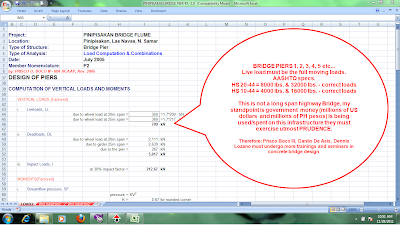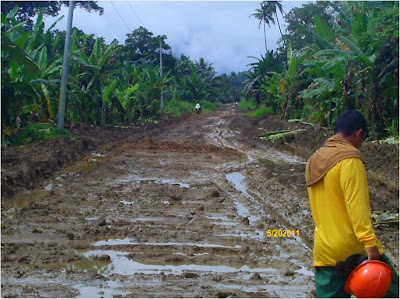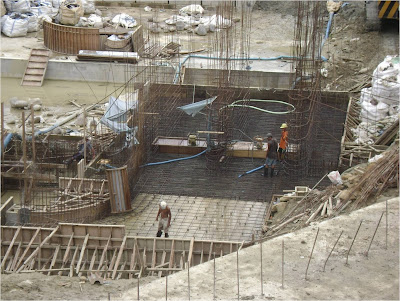Based on the evidences and records which I have at hand:
At the time when KALAHI-CIDSS had started, it had occurred on May 9, 2007 when kalahi engineer Steve Abrogar transmitted a letter to LGU engineer Mrs. Nora Cananua informing her that the only lacking in the documents was her signatures for the request for fund release (RFR) and submission to the Department of Social Wefare and Development (DSWD) Regional and National offices and from the World Bank, and then on June 5, 2007 (date verified), the Mayor issued a Memorandum to the LGU engineer Nora Cananua, the excerpt is "You are hereby directed to facilitate the approval of work plans and specifications, program of works of the 14 priority KALAHI-CIDSS project of this municipality on or before June 7, 2007" the signing of voluminous documents, but Nora Cananua was unwilling to cooperate she asked many requirements, documents as per her letter to the deputy area coordinator dated May 10 and May 22, 2007 (date verified).
As theirs best recourse and solution of the problem, the Mayor and Vice Mayor resorted to use me.
Here is the story of the success and failures:
On June 8, 2007 (date verified), the day of the feast of San Antonio the Padua, almost a month after the Local election in May 10, 2007, an event in my father’s house (our house) when the kalahi-cidss Area coordinator Mr. Noel Pesquera and the kalahi engineer Mr. Steve Abrogar went there and we met, by surprise he handed-over his mobile phone to me and then he said to me and I quote! “Mayor Bugna is on the line”, promptly I held his mobile phone and answered, “hello! Mayor good morning!” the Mayor told me, and I quote! “You help them in the process of the documents for the KALAHI-CIDSS projects and you sign the plans, documents.” By these order I was amazed by these RISKY NEW TASKS because I was not aware and well informed of these projects, when in fact and the truth they have their own municipal engineer that has a function and authority to handle those projects. By surprise I answered hastily, “YES! MAYOR” It was because in my senses (my mind) and my feeling (heart) I was then waiting for the HELP of the MAYOR that someday (for the time being on his goodwill) he would open his mind and his generosity to me, as a return for my obedience to him. Consequently, I told the two (2) men of kalahi-cidss that we should meet at my private office at our house, and so, they brought to my office house the voluminous documents for the first (1) CYCLE, which consists of 14 projects (Php 10 Million) for 14 barangays of the municipality of Mondragon. These projects consisted the following;
- 4 units- School Buildings (Dona Lucia-3rooms, Makiwalo-2rooms, Bugko-2rooms, San Antonio-2rooms)
- 2- Footbridges (La Trinidad, Talolora)
- 6 units- Water supply system (Santa Catalina, San Isidro, Cablangan, Nenita, Demaria, San Jose)
- 1unit- Drainage system (Roxas)
- 1 unit- Solar Dryer (Mirador)
Unfortunately, I was not aware that there was these kind of projects about the process and implementations of the said projects, because during barangay assembly meetings I was not invited even a single meeting, I was not informed by the Mayor, by the DSWD-KALAHI-CIDSS personnel for the preparation of those projects, it’s because of their consideration to their LGU municipal engineer (wiseacre engineer, an obstinate, whose purpose was to delay and get five(5%) percent from these projects for her assistance to the engineer, an appointee of the late Mayor Dapulag) favored by her political party, who was then not cooperating to the administration of Mayor Bugna Jr. Consequently, I’ve tried to be compliant to my boss, “Were it not for the Mayor (out of consideration for him).” I sat down and gazed (look long and steadily) these voluminous documents, while the kalahi-cidss engineer one by one scanned the documents, and then he pointed to me the place and space where should be the space I should sign. It was a risky decision (choice, judgment) in my life as a registered professional civil engineer to sign documents which I did not read and peruse the papers and documents I was signing. In my belief that my boss will ultimately open his heart to give me reward and/or should I say” HELP” for a person in need of help.
Accordingly, I closed my two (2) eyes (Pikit MATA ako in local dialect) then I signed the 13 projects for thirteen Barangays and retained one (1) project which I have to review and check plan and estimates for the proposed footbridge for Barangay Talolora, because in my judgement and/or findings it was not planned, drawn as per standard engineering practice, it was drawn by a certain Jeffrey Mangada a draftsman as per request of Kalahi engineer. This draftsman is also professing that he is an Engineer and Architect although he graduated only Bachelor in Technology, major in architectural drafting (No KNOWLEDGE about Reinforced Concrete Design, Structural Timber Design, Structural Steel Design, Engineering Mechanics, Theory of Structures, Strength of Materials (or Mechanics of Materials), Hydraulics and application of these subjects to Structural Analysis and Design), at the University of Eastern Philippines with certificate of passing the TESDA exam, when he passed after 5 times of TESDA exams and converted this to Sub-Professional eligibility.
Subsequently, after one week they came back to me to follow up the plan, estimates, program of works for my review and signature, so I told them to revise the plans, because it appears, it does not conforms to the standard engineering practice, the design strength is less than the required strength, I had required them to submit the Structural Analysis (Computations) and Design Calculations, so that, I should have the basis for checking the plans for the design strength of the 11 meters span and 66 meters long concrete footbridge. Hence, they brought back with them the plans and program of work for their revision, because at that time my TASK was just to review and sign the voluminous documents.
Three(3) weeks had passed; on July 8, 2007, they came back again with computer printed structural analysis (Calculations) for my review, it appeared they borrowed from provincial engineering office intended for 5 meters span footbridge, so I checked it and noted my findings and made corrections, I told them the calculations for 5 meters span footbridge is not the same or it would not match with the intended plans for 11 meters span footbridge, bring to me a correct calculations and immediately I will sign it period.”
God is my witness I am not a corrupt engineer, at that point in time I was just apprehensive with my profession, and my license might be put prejudicial. Until such time when they were unable to produce and submit analysis (computations) for the 11 meters span footbridge, and so, it had occurred to them to make a decision to make a deal with me that I will be the one to undertake the ANALYSIS (computations), I had agreed but with a condition that they would pay professional service fee of one and half percent (1.5%) of the project cost (this is a fair and just professional fee for a civil engineer) and this was for the services which I've rendered to them, because I was not the municipal engineer I was only given a meager salary as contractual employee, in fact I was only helping them being used as signatory for their accomplishment, it was their job and task. So therefore, I hurriedly done the analysis (computations) and sketches for the plans, because I was then hoping at that time that they were good people and that they would hold and be faithful to what we had agreed upon, and they promised to me. Unfortunately I was not aware that they were unwilling to pay me; instead they complained and urged the Mayor Bugna that I was asking for payment for my services.
Moreover, I went to Manila for the renewal of my PRC license, when I arrived on August 4, 2007, Mayor Bugna invited me to his residence there I got pressure from him, he asked me, "what happened what is the problem in the documents for the footbridge in Barangay Talolora? Why did you refuse to sign the documents and help the process?" I explained to him slowly with mildness of my voice the reasons why I did not sign the last project of the first cycle, It was because they did not submit the analysis(computations) and they asked me to make the analysis and because they don’t know they procedure how to prepare, you know Mayor they lack in actual practice. Consequently, I was astonished to his reply the threatening words when he said to me and I quote “Pusilon ta ikaw!" this word he uttered was in local dialect (I'll SHOOT YOU! in english). From then on I was evading his presence because of fear to him. After 4 days on August 8, 2007, he invited me again at his office to sign the document, so I signed promptly telling them in front of the Mayor and kalahi engineer, “Had it not been for the Mayor (out of consideration for him) I will not sign these documents! My only witness is God he knew everything to what had occurred for the first cycle of KALAHI.
On November 20, 2007 after almost 4 months I was surprised again when Matias Cabalitan invited me, he also threatening me to leave them ("Ayaw sa am didi" in local waray waray dialect) if the KALAHI engineers won’t be able to implement the projects when in fact they were implementing at that time the 13 projects for 13 barangays, the construction of said projects were on-going, and I have signed already the plans and program of works for the footbridge in barangay Talolora the #14 project, and there was no need for the analysis (computations) because I signed it already "Ah! maybe they were making some alibis to blame me.
Again on May 2008, the second (2) cycles of kalahi-cidss amounting to Php9, 750473.00 had been submitted to me for my review and signature; the list of the projects are the following;
- 3 units - School buildings ( Imelda-2rooms, Roxas-2rooms, Bagasbas-3rooms),
- 1 unit - Flood control with stone masonry (Chitongcco)
- 1 unit - Drainage canal system (Eco)---this was the project that prompted me to leave my Boss the Mayor (please see the story entitled: Hydraulics, My father and Juan Dela Cruz)
- 2 units - Day care center (San Agustin-1room, Hinabangan-1room)
- 1- Farm to Market road (San Juan)
- 1- River control and landing (Cahicsan)
- 1 unit - Water supply system level 2 (Flormina)
Finally, the third (3) cycles of kalahi-cidss came on March 2009 and it was submitted to me for review in the amount of Php10, 000,000.00); the list of the projects are the following;
On July 23, 2008 (date verified), I had observed that the method of construction for drainage was incorrect, so I looked for the barangay Eco chairman Mr. Marlito Bugna a brother of the Mayor, and then I introduced some suggestions to him, I suggested that they should use engineer's transit or level instrument, but he insisted that, they are just using traditional method only! using plastic leveling hose because there was no funds included in the program of works, I will quote his exact words to me "we are going to use traditional method only! using plastic leveling hose okay na, isn't it?" so I humbly argued with him, that it is not good to use leveling hose it might result to a problem, because the drainage canal might overflow, I humbly suggested to him that they should use survey instrument, like theodolite or engineer's transit, level instrument, but he said "there is no funding for the survey, the KALAHI would not allow it! Is it not before you are the municipal engineer, but now, you are not!" What a sarcastic remarks? my conjecture I felt insulted, I discerned that he was annoyed of my being persistent. The result was a failure because of shortcoming on his part and to their part.
- 5 units - School buildings (La Trinidad-2-rooms, Flormina-2-rooms, Cablangan-3-rooms, San Jose-2-rooms, Cagmanaba-1-room),
- 1 unit - Fish port building or Bagsakan of fish and agricultural products (Makiwalo),
- 1- Sea wall and river control (Eco),
- 1- Road re-gravelling with stone masonry (Chitongco),
- 1- River control (Roxas),
- 1- Drainage canal system (Hinabangan)
In my discernment and comprehension I have no option to choose but to deal with them and be humble myself, they submitted the 3rd cycles projects to me for review (a formality word "for review") but in reality no review at all because they do not want or allow me that their works be reviewed by me, so again I had closed my two (2) eyes then I signed all the program of works in front of the Mayor, eventhough there were no plans, drawings for seawall and river control, fish port and roads the only available are program of works for my signatures.
- 12 units -School Buildings- 26 rooms
- 2 units -Day care center buildings- 2 rooms
- 1 unit - Fish port building or bagsakan
- 7 units -Water supply system level 2
- 2 units -Footbridges 80 linear meters
- 3 units -Drainage system 2 kilometers
- 1 - Farm to market road
- 1 - Seawall and river control
- 2 - River control and landing
- 1 - Road regravelling with stone masonry
- 1 - Flood control with stone masonry
- 1 - Solar dryer
Hence, this was the story behind of KALAHI-CIDSS projects which I had signed, for the information and reference of the people who are not well-informed and aware of these projects which I was the sole responsible, sole signatory civil engineer on the part of the local government unit - LGU of Mondragon, Northern Samar, Philippines. I can keep shouting aloud to the people of Mondragon and to the whole world that my education, and my profession was used by the politicians, my kababayan as a whole, because the LGU- municipal engineer who was then not cooperating with the Mayor, recalcitrant, stubborn person, who was then asking five (5%) percent of the project cost for her assistance to the engineer demands, and the Mayor, the Vice Mayor could not compel and coerce her to sign these kalahi-cidss projects (Php30,000,000.00).
Therefore, I challenge everyone Carpenters, Masons, Plumbers, Pastors, Priests, Teachers (Education, Elementary and secondary, Agriculture education graduate), Architectural DRAFTSMAN (BT), Business Administration (commerce graduate), Community Development (CD), AB Political Science graduates, Lawyers, Doctors, Mechanical, Agricultural, Architectural, Electrical, Chemical engineering graduates (ME, AE, EE, CheE), politicians not degree holder to enroll in the College of Civil Engineering at any University and/or college to learn about Civil Engineering.
References: The books below are on the shelves in my Personal Library for additional background information.
Therefore, I challenge everyone Carpenters, Masons, Plumbers, Pastors, Priests, Teachers (Education, Elementary and secondary, Agriculture education graduate), Architectural DRAFTSMAN (BT), Business Administration (commerce graduate), Community Development (CD), AB Political Science graduates, Lawyers, Doctors, Mechanical, Agricultural, Architectural, Electrical, Chemical engineering graduates (ME, AE, EE, CheE), politicians not degree holder to enroll in the College of Civil Engineering at any University and/or college to learn about Civil Engineering.
References: The books below are on the shelves in my Personal Library for additional background information.
- TREATISE ON HYDRAULICS by Mansfield and Thaddeus Merriman, 1st-1889, 3rd-1890, 4th-1891, 5th-1895, 6th-1898, 7th -1900, 8th edition-1910, 9th edition-1912;
- A TREATISE ON HYDRAULICS by Henry T. Bovey, 1st edition -1895, 2nd edition-1901 and 1908;
- A TREATISE ON HYDRAULICS by Hector G. Hughes and Arthur T. Safford -1911;
- A TREATISE ON HYDRAULICS by William Cawthorne Unwin-1907;
- HYDRAULICS by Venancio Besavilla -1987;
- HYDRAULICS by Matias Arreola -1989;
- HYDRAULICS by Horace W. King and Chester O. Wisler-1922;
- HYDRAULICS by F. C. Lea -1907;
- HYDRAULICS by R. L. Daugherty, 1st edition-1916, 2nd edition -1919;
- Concrete-Steel Construction by Emil Morsch 1910;
- Reinforced Concrete Construction -Fundamental Principles, volume 1, George A. Hool -1912;
- Reinforced Concrete Construction -Buildings and Retaining Walls, volume 2, George A. Hool -1913;
- Reinforced Concrete Construction -Bridges and Culverts, volume 3, by George A. Hool -1916;
- Handbook of Building Construction volume 1 and 2 by George A. Hool and Nathan C. Johnson-1929;
- Structural Analysis by Jack C. McCormac and J. K. Nelson, Jr. -1997.























